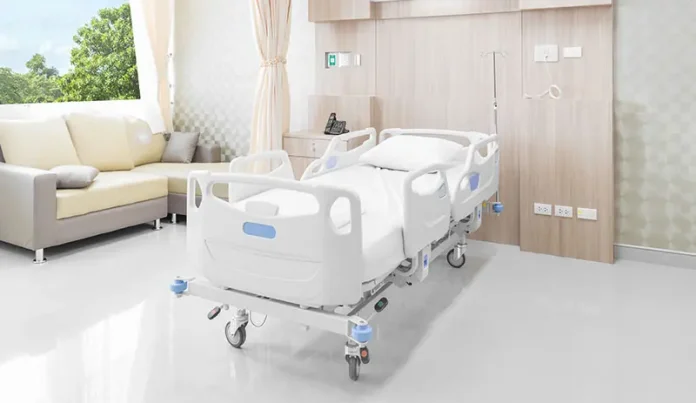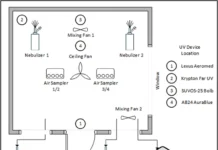Compiled by Isabel “Izzy” Medeiros and James P. Malley, Jr., Ph.D., University of New Hampshire
For this issue, the authors sought to better understand barriers to the use of UV surface disinfection equipment in hospital settings. The B2B Data Supplier was used to access emails in the Healthcare Facility industry, resulting in 700 health systems in North America that are responsible for about 7,000 hospitals. Email invitations for the Qualtrics survey were sent to those responsible for leading Infection Control Teams, Infection Preventionists and/or Infection Control. Of the 100 invitations sent, about 75 did not bounce back and, of those, 12 responses were received.
Are any of your healthcare facilities using ultraviolet technologies as part of your infection control program(s). If so, what is being used, how and where?
Half of the respondents indicated that UV devices were purchased during the pandemic and used as part of the housekeeping process in their healthcare facilities but were unsure if those practices by housekeeping have continued. Four respondents indicated that the primary purpose of these “expensive” UV mobile devices was to provide peace of mind for their staff and their patients. The remaining responses indicated that UV technologies were not and are not being used, to the best of their knowledge. None of the respondents indicated that upper-room UV technologies or similar permanent in-room or building facilities currently were in use.
One respondent referenced an article, “Shedding a light on ultraviolet-C technologies in the hospital environment,” 1 indicating that the concerns raised in that paper have not been adequately addressed in carefully designed and funded research and that has eliminated UV technology from additional consideration in their healthcare system until these questions are adequately resolved. One respondent stated that the possibility of using UV technologies in high-impact areas, such as ICU, NICU, surgical suites and isolation units, was discussed thoroughly, but potential health risks to hospital staff working in those areas from unanticipated or low-level exposure to UV-C on a routine basis were considered unacceptable compared to potential benefits.
If your healthcare facilities were to evaluate the potential of using UV technologies for infectious disease control and/or reduction in the frequency of HAIs, what factors would you consider to be important?
All responses mentioned directly or indirectly either cost/benefit analysis or risk/benefit analysis as an important management determination. Five responses indicated a need to see conclusive results demonstrating effectiveness published in high-quality journals, such as the American Journal of Infection Control. Two responses indicated that proving effectiveness would be challenging in most actual hospital settings and would need to be conducted in double-blind trials to be conclusive enough to warrant investment. Six respondents indicated that the probability of a positive decision being made by management, as well as by legal, would improve if due diligence identified other healthcare facilities here or abroad that had documented multi-year, data-proving success with using UV technologies for infection control.
Eight of the respondents indicated that firm guidance from federal and state agencies, such as FDA, CDC, departments of public health in counties, states and/or provinces, and the independent The Joint Commission2 would be needed before they could foresee any type of widespread use of UV technologies in healthcare facilities.
Please add any questions or comments that you may have related to this topic of applying UV technology in healthcare facility settings.
Half of the respondents, in one form or another, urged the IUVA to push for increased federal research funding (e.g., FDA, EPA, NIH) that would investigate and publish supporting data on the effectiveness of using UV technologies in healthcare facility settings. Three respondents indicated that the line-of-sight nature of UV technologies make it difficult to imagine systems that could compete with the conventional chemical-disinfection techniques currently in use for hospital facility surfaces and equipment.
Half of the respondents indicated that UV disinfection will continue to struggle with public perception from patients and staff due to the well-known correlations between UV from the sun and the increased incidence of skin cancers and eye diseases. One respondent indicated an awareness of recent Threshold Limit Values (TLVs) published by the American Conference of Governmental Industrial Hygienists (ACGIH) indicating that Far UV-C poses less of a risk to exposed skin and eyes.
One respondent shared a response from its facility’s housekeeping supervisor who indicated the devices were used during COVID-19 but have been parked ever since because they add an entire extra step to routine housekeeping and the staff could never tell if it was doing anything or not. Four respondents asked that IUVA make information available on the effectiveness of UV technologies for inactivation of avian influenza A (H5 and H5N1). One respondent was seeking information from IUVA on the effectiveness of UV technologies to control Mpox virus.
Summary
Despite the modest number of respondents to the survey, there are several key takeaways that can inform the UV industry when addressing applications in healthcare. These include the following:
- UV technology is perceived as expensive and laborious to sustain;
- peer-reviewed literature, especially related to patient outcomes, is thin and variably supportive; and
- key healthcare stakeholders don’t know the difference between UV-A, UV-B and UV-C, so consider application of any UV technologies a real risk for causing skin cancer and eye disease.
Acknowledgement
A special thank you to UV Solutions Editorial Board Member Richard A. Martinello, MD, FIDSA, Chief Medical Officer, Yale Medicine, for his review and improvements made to this column.
References
- Shedding a light on ultraviolet-C technologies in the hospital environment, N. Demeersseman, V. Saegeman, V. Cossey, H. Devriese, A. Schuermans, https://pmc.ncbi.nlm.nih.gov/articles/PMC9769028/
- The Joint Commission, https://www.jointcommission.org
- ACGIH 2021 Threshold Limit Values and Biological Exposure Indices, https://uvmedico.com/research-and-publications/acgih-2021-threshold-limit-values-tlvs-and-biological-exposure-indices-beis






